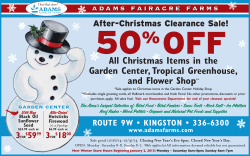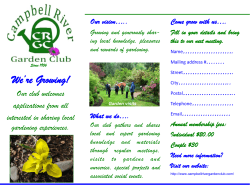
Sample Garden Budget Worksheet
Sample Garden Budget Worksheet This worksheet should help you generate a list of materials, and their associated cost, for developing a garden to complement this curriculum. Listed prices are rough figures; confirm the actual price with the source before you purchase anything. Use this budget to present to funders or include in grant applications. Container Garden Item Number required Cost per item Containers with drainage holes (various sizes—1quart-5gallon) FREE (get 5-gallon buckets from food stores!) OR up to $10.00 each Potting soil $4.00/16 quart bag Organic fertilizer $6.00/5 lb bag Seeds FREE (request last year’s seeds from seed companies) OR $2.00/ packet Seedlings $3.00 each Hand trowels $3.00 each Gloves $2.00/pair Watering cans $6.00 each Grand total: v Total cost Sample Garden Budget Worksheet This worksheet should help you generate a list of materials, and their associated cost, for developing a garden to complement this curriculum. Listed prices are rough figures; confirm the actual price with the source before you purchase anything. Use this budget to present to funders or include in grant applications. In-ground Garden Item Number required Cost per item Total cost Soil test (Standard soil test w/ organic matter UMASS Soil Testing Lab) 1 (every 3 years) $15.00 $15.00 + shipping Leaf compost $5.00/ 1.5 cubic feet Untreated wood for raised beds—2x6’s or 2x8’s; shortest side 3’ long Dimensional lumber prices vary. Check with your local lumber yard Topsoil $2.50/40 lb. bag or $50/ cubic yard + delivery Seeds $2.00/packet Transplants Garden Rakes Shovels $3.00 each No more than 2 $10.00 each or borrow as needed No more than 3 $10.00 each or borrow as needed Hand trowels $3.00 each Gloves $2.00/pair Hose $15.00 (50 foot) Watering wand $5.00 each Watering cans $6.00 each Grand total: vi Sample Garden Budget Worksheet This worksheet should help you generate a list of materials, and their associated cost, for developing a garden to complement this curriculum. Listed prices are rough figures; confirm the actual price with the source before you purchase anything. Use this budget to present to funders or include in grant applications. In-ground Garden Item Number required Cost per item PVC pipe and fittings to build light stand $20 Florescent shop light with bulbs $20 Growing containers FREE (if using milk jugs) or up to $5 per pot Potting soil 2 quarts per each milk jug, or quantity needed for your chosen containers $4.00/16 quart bag Organic fertilizer $6.00/5 lb bag Seeds $2.00/packet Gloves $2.00/pair Watering cans $6.00 each Grand total: vii Total cost Youth Gardening Program Planning Document Use this document to organize your ideas, inventory your resources and assess your needs in developing your gardening program. Engage other teachers / staff / volunteers at your site in the process. viii Building A Youth Garden Team Do you have commitment or buy in from all necessary stakeholders? Who needs more information to be persuaded? What types of information should you present to them? Which of the stakeholders are going to part of your gardening team? Who is going to lead this team? Who in this team needs training? What type of training? How is that training going to happen? Who is deciding the goals and activities of the garden? Who will provide gardening expertise? Who will be teaching the educational content of the gardening program? Where will you get the labor to build the garden? How many volunteers do you need to recruit? How will you establish clear lines of communication around the garden? Appendix ix Defining Your Program Who is your target audience? • Age range? • Specific demographics? (low income, special needs, etc.) • How many students will be using the garden? Describe the site: • In school • After school • Summer During what months will your program run? When will gardening occur? When will programming (lessons, etc.) occur? How often? What are YOUR goals for the program? What are the goals of the SITE? How do your goals and the goals of the site intersect? Appendix What type of garden will you have? • Raised beds, • in ground, • containers How big will your garden be? How many beds/pots? What size beds/pots? Is this an appropriate size to meet your goals? Where will your garden be located? Does this location have: • Sunlight • Easy access for students, staff, and volunteers • Water What plants have you had success growing in the past? What crops meet your curricular needs? x The Garden Design Do you have a garden plan? This should include a map of your space(s), planting layouts for the season (where and how much you will plant), a planting schedule, and a maintenance plan. Who will you contact for assistance to create this plan? Who will plant the garden? Who will maintain the garden (watering, weeding)? How will summer maintenance and harvesting occur (for school gardens)? How will produce from the garden be used? Appendix ___ fencing ___ lumber for raised beds ___ containers ___ soil compost, and amendments ___ mulch ___ tools ___ seeds, seedlings ___ watering supplies ___ harvesting equipment ___ food preparation and serving materials ___ other Physical Resources Keeping your goals in mind, what materials do you need to build, expand or better use your garden? Which items can be obtained from: • Donations • Municipal Resources • Borrowing For items you will purchase, where will you get the funds? • Donations (from garden clubs, community businesses)? • Small grants? (list any you anticipate applying for) How much money do you need for startup costs? ___ curricular / educational materials ___ food preparation and serving materials Where will tools and other materials be stored? Is this accessible to the people who will be maintaining the garden? What materials do you need that can be paid for with FSNE / EFNEP / 4H funds? ___ mulch ___ seeds, seedlings ___ fertilizer or compost xi What materials do you need each year to maintain the garden? Which can be obtained through donations? Appendix Are you currently using a gardening curriculum? If yes, list curriculum(s) and source(s). Educational Resources Do you feel that the curriculums you have available to you will allow you to adequately meet the educational goals of your program? What other content/resources do you need to identify in order to reach your educational goals in the garden? xii Evaluation Revisit the goals for your gardening program listed in the first section. List specific, measurable indicators that you will use to assess your success in meeting your goal(s). How will you collect data on the above indicators? Appendix
© Copyright 2025









